Financial Analysis Project: Blackmores Company Report
VerifiedAdded on 2023/01/11
|10
|2446
|34
Project
AI Summary
This project provides a comprehensive financial analysis of Blackmores, an Australian listed company. It begins with an examination of Blackmores' corporate governance structure, policies, and their alignment with stakeholder interests. The project then delves into the company's cash conversion cycle, comparing its performance in 2018 and 2019, identifying key drivers of change. Furthermore, it calculates and discusses Blackmores' net working capital, exploring its asset management strategy, and outlining the pros and cons. The project also identifies and categorizes major financial risks, including liquidity, credit, and interest rate risks. An analysis of Blackmores' share price is presented, considering dividend growth and market risk. The project concludes with the determination of the issue price of bonds, followed by a capital budgeting analysis of a new manufacturing facility. This includes calculating free cash flows (FCFs), net present value (NPV) at different discount rates, and the discounted payback period, culminating in a justification for the investment decision. The project utilizes financial data and calculations to support its conclusions, offering insights into Blackmores' financial performance and investment potential.

Project
Paraphrase This Document
Need a fresh take? Get an instant paraphrase of this document with our AI Paraphraser

Table of Contents
Table of Contents.............................................................................................................................2
INTRODUCTION...........................................................................................................................1
COMPANY PESPECTIVE.............................................................................................................1
a. analysis of the way in which Blackmore’s governance is organised.......................................1
b. calculation and discussion of the way in which cash conversion cycle of Blackmore is
changed during year 2018 and 2019............................................................................................1
c. What is the net working capital of Blackmore, which asset management strategy is used by
the company and props and cons of this strategy........................................................................3
d. Identification of three major risks in the annual report and these are systematic or not.........4
e. Analysis of the share price of Blackmore................................................................................4
f. Determination of the issue price of the bonds..........................................................................5
CAPITAL BUDGETING................................................................................................................6
a. Calculation of FCFs of the project...........................................................................................6
b. Calculation of NPV of the new manufacturing facility of the entity.......................................6
c. Discounted pay-back period for the project.............................................................................7
d. Justification regarding selecting the project or not..................................................................7
CONCLUSION................................................................................................................................7
REFERENCES................................................................................................................................8
Table of Contents.............................................................................................................................2
INTRODUCTION...........................................................................................................................1
COMPANY PESPECTIVE.............................................................................................................1
a. analysis of the way in which Blackmore’s governance is organised.......................................1
b. calculation and discussion of the way in which cash conversion cycle of Blackmore is
changed during year 2018 and 2019............................................................................................1
c. What is the net working capital of Blackmore, which asset management strategy is used by
the company and props and cons of this strategy........................................................................3
d. Identification of three major risks in the annual report and these are systematic or not.........4
e. Analysis of the share price of Blackmore................................................................................4
f. Determination of the issue price of the bonds..........................................................................5
CAPITAL BUDGETING................................................................................................................6
a. Calculation of FCFs of the project...........................................................................................6
b. Calculation of NPV of the new manufacturing facility of the entity.......................................6
c. Discounted pay-back period for the project.............................................................................7
d. Justification regarding selecting the project or not..................................................................7
CONCLUSION................................................................................................................................7
REFERENCES................................................................................................................................8
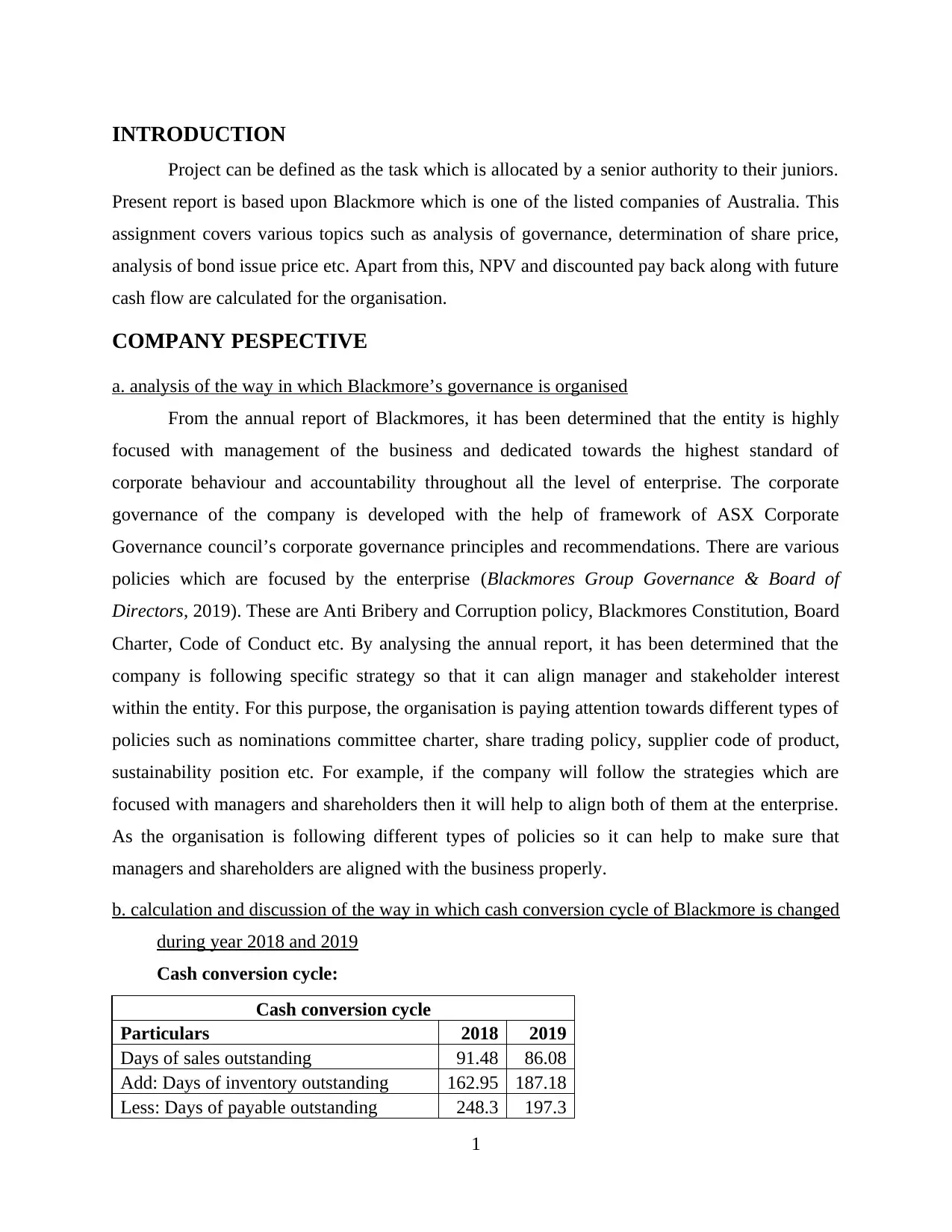
INTRODUCTION
Project can be defined as the task which is allocated by a senior authority to their juniors.
Present report is based upon Blackmore which is one of the listed companies of Australia. This
assignment covers various topics such as analysis of governance, determination of share price,
analysis of bond issue price etc. Apart from this, NPV and discounted pay back along with future
cash flow are calculated for the organisation.
COMPANY PESPECTIVE
a. analysis of the way in which Blackmore’s governance is organised
From the annual report of Blackmores, it has been determined that the entity is highly
focused with management of the business and dedicated towards the highest standard of
corporate behaviour and accountability throughout all the level of enterprise. The corporate
governance of the company is developed with the help of framework of ASX Corporate
Governance council’s corporate governance principles and recommendations. There are various
policies which are focused by the enterprise (Blackmores Group Governance & Board of
Directors, 2019). These are Anti Bribery and Corruption policy, Blackmores Constitution, Board
Charter, Code of Conduct etc. By analysing the annual report, it has been determined that the
company is following specific strategy so that it can align manager and stakeholder interest
within the entity. For this purpose, the organisation is paying attention towards different types of
policies such as nominations committee charter, share trading policy, supplier code of product,
sustainability position etc. For example, if the company will follow the strategies which are
focused with managers and shareholders then it will help to align both of them at the enterprise.
As the organisation is following different types of policies so it can help to make sure that
managers and shareholders are aligned with the business properly.
b. calculation and discussion of the way in which cash conversion cycle of Blackmore is changed
during year 2018 and 2019
Cash conversion cycle:
Cash conversion cycle
Particulars 2018 2019
Days of sales outstanding 91.48 86.08
Add: Days of inventory outstanding 162.95 187.18
Less: Days of payable outstanding 248.3 197.3
1
Project can be defined as the task which is allocated by a senior authority to their juniors.
Present report is based upon Blackmore which is one of the listed companies of Australia. This
assignment covers various topics such as analysis of governance, determination of share price,
analysis of bond issue price etc. Apart from this, NPV and discounted pay back along with future
cash flow are calculated for the organisation.
COMPANY PESPECTIVE
a. analysis of the way in which Blackmore’s governance is organised
From the annual report of Blackmores, it has been determined that the entity is highly
focused with management of the business and dedicated towards the highest standard of
corporate behaviour and accountability throughout all the level of enterprise. The corporate
governance of the company is developed with the help of framework of ASX Corporate
Governance council’s corporate governance principles and recommendations. There are various
policies which are focused by the enterprise (Blackmores Group Governance & Board of
Directors, 2019). These are Anti Bribery and Corruption policy, Blackmores Constitution, Board
Charter, Code of Conduct etc. By analysing the annual report, it has been determined that the
company is following specific strategy so that it can align manager and stakeholder interest
within the entity. For this purpose, the organisation is paying attention towards different types of
policies such as nominations committee charter, share trading policy, supplier code of product,
sustainability position etc. For example, if the company will follow the strategies which are
focused with managers and shareholders then it will help to align both of them at the enterprise.
As the organisation is following different types of policies so it can help to make sure that
managers and shareholders are aligned with the business properly.
b. calculation and discussion of the way in which cash conversion cycle of Blackmore is changed
during year 2018 and 2019
Cash conversion cycle:
Cash conversion cycle
Particulars 2018 2019
Days of sales outstanding 91.48 86.08
Add: Days of inventory outstanding 162.95 187.18
Less: Days of payable outstanding 248.3 197.3
1
⊘ This is a preview!⊘
Do you want full access?
Subscribe today to unlock all pages.

Trusted by 1+ million students worldwide
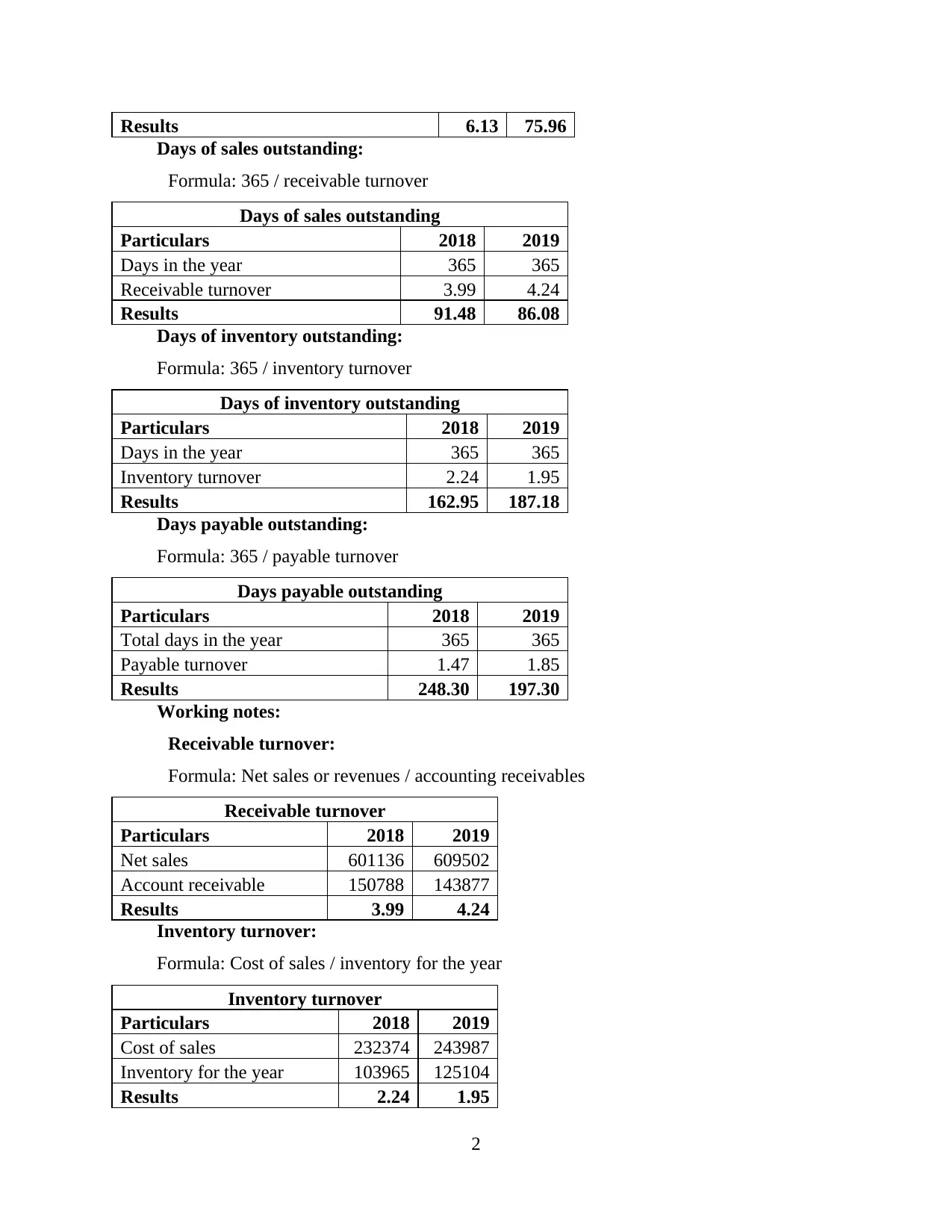
Results 6.13 75.96
Days of sales outstanding:
Formula: 365 / receivable turnover
Days of sales outstanding
Particulars 2018 2019
Days in the year 365 365
Receivable turnover 3.99 4.24
Results 91.48 86.08
Days of inventory outstanding:
Formula: 365 / inventory turnover
Days of inventory outstanding
Particulars 2018 2019
Days in the year 365 365
Inventory turnover 2.24 1.95
Results 162.95 187.18
Days payable outstanding:
Formula: 365 / payable turnover
Days payable outstanding
Particulars 2018 2019
Total days in the year 365 365
Payable turnover 1.47 1.85
Results 248.30 197.30
Working notes:
Receivable turnover:
Formula: Net sales or revenues / accounting receivables
Receivable turnover
Particulars 2018 2019
Net sales 601136 609502
Account receivable 150788 143877
Results 3.99 4.24
Inventory turnover:
Formula: Cost of sales / inventory for the year
Inventory turnover
Particulars 2018 2019
Cost of sales 232374 243987
Inventory for the year 103965 125104
Results 2.24 1.95
2
Days of sales outstanding:
Formula: 365 / receivable turnover
Days of sales outstanding
Particulars 2018 2019
Days in the year 365 365
Receivable turnover 3.99 4.24
Results 91.48 86.08
Days of inventory outstanding:
Formula: 365 / inventory turnover
Days of inventory outstanding
Particulars 2018 2019
Days in the year 365 365
Inventory turnover 2.24 1.95
Results 162.95 187.18
Days payable outstanding:
Formula: 365 / payable turnover
Days payable outstanding
Particulars 2018 2019
Total days in the year 365 365
Payable turnover 1.47 1.85
Results 248.30 197.30
Working notes:
Receivable turnover:
Formula: Net sales or revenues / accounting receivables
Receivable turnover
Particulars 2018 2019
Net sales 601136 609502
Account receivable 150788 143877
Results 3.99 4.24
Inventory turnover:
Formula: Cost of sales / inventory for the year
Inventory turnover
Particulars 2018 2019
Cost of sales 232374 243987
Inventory for the year 103965 125104
Results 2.24 1.95
2
Paraphrase This Document
Need a fresh take? Get an instant paraphrase of this document with our AI Paraphraser

Payable turnover:
Formula: Cost of sales / account payable
Payable turnover
Particulars 2018 2019
Cost of sales 232374 243987
Account payable 157868 131833
Results 1.47 1.85
By analysing the results of cash conversion cycle, it has been determined that for 2018 it
was 6.13 and in 2019 a major change in it took place it is increased with a higher percentage. For
2019 CCC is 75.96 which is very high (Blackmore, 2017). When the annual report of the
organisation was analysed then it is determined that the CCC for year 2019 is increased. The
main causes of this increment are increased payable and receivable turnover for 2019. On the
other hand, inventory turnover is also decreased in the year and due to all these changes CCC for
year 2019 is increased. The comparison is done with the help of appropriate data there is no
requirement of any additional data.
c. What is the net working capital of Blackmore, which asset management strategy is used by the
company and props and cons of this strategy
Working capital: It is the total difference between current assets and liabilities of the
organisation which is utilised to meet the short-term obligations to perform operations
systematically. Calculation of it for the organisation is as follows:
Formula: Current assets – current liabilities
For 2018:
= 302507 – 174467
= 128040
For 2019:
= 305526 – 150509
= 155017
The organisation is using performance-based asset management strategy so that it can
deal with all the uncertainties which may take place (Blackmore, 2019). The managers try to
formulate future policies on the basis of current performance of the company. Some of the pros
and cons of this strategy are as follows:
Pros:
3
Formula: Cost of sales / account payable
Payable turnover
Particulars 2018 2019
Cost of sales 232374 243987
Account payable 157868 131833
Results 1.47 1.85
By analysing the results of cash conversion cycle, it has been determined that for 2018 it
was 6.13 and in 2019 a major change in it took place it is increased with a higher percentage. For
2019 CCC is 75.96 which is very high (Blackmore, 2017). When the annual report of the
organisation was analysed then it is determined that the CCC for year 2019 is increased. The
main causes of this increment are increased payable and receivable turnover for 2019. On the
other hand, inventory turnover is also decreased in the year and due to all these changes CCC for
year 2019 is increased. The comparison is done with the help of appropriate data there is no
requirement of any additional data.
c. What is the net working capital of Blackmore, which asset management strategy is used by the
company and props and cons of this strategy
Working capital: It is the total difference between current assets and liabilities of the
organisation which is utilised to meet the short-term obligations to perform operations
systematically. Calculation of it for the organisation is as follows:
Formula: Current assets – current liabilities
For 2018:
= 302507 – 174467
= 128040
For 2019:
= 305526 – 150509
= 155017
The organisation is using performance-based asset management strategy so that it can
deal with all the uncertainties which may take place (Blackmore, 2019). The managers try to
formulate future policies on the basis of current performance of the company. Some of the pros
and cons of this strategy are as follows:
Pros:
3
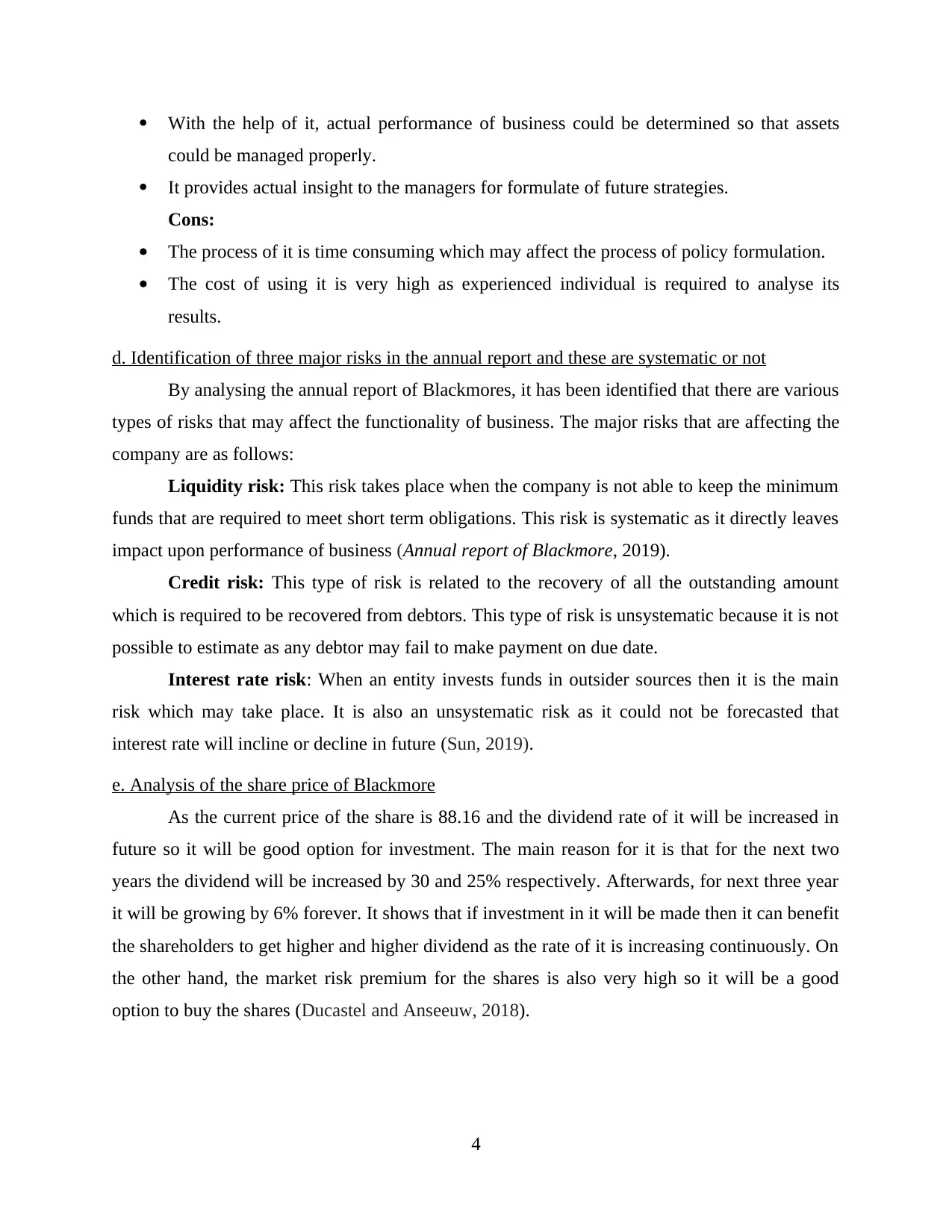
With the help of it, actual performance of business could be determined so that assets
could be managed properly.
It provides actual insight to the managers for formulate of future strategies.
Cons:
The process of it is time consuming which may affect the process of policy formulation.
The cost of using it is very high as experienced individual is required to analyse its
results.
d. Identification of three major risks in the annual report and these are systematic or not
By analysing the annual report of Blackmores, it has been identified that there are various
types of risks that may affect the functionality of business. The major risks that are affecting the
company are as follows:
Liquidity risk: This risk takes place when the company is not able to keep the minimum
funds that are required to meet short term obligations. This risk is systematic as it directly leaves
impact upon performance of business (Annual report of Blackmore, 2019).
Credit risk: This type of risk is related to the recovery of all the outstanding amount
which is required to be recovered from debtors. This type of risk is unsystematic because it is not
possible to estimate as any debtor may fail to make payment on due date.
Interest rate risk: When an entity invests funds in outsider sources then it is the main
risk which may take place. It is also an unsystematic risk as it could not be forecasted that
interest rate will incline or decline in future (Sun, 2019).
e. Analysis of the share price of Blackmore
As the current price of the share is 88.16 and the dividend rate of it will be increased in
future so it will be good option for investment. The main reason for it is that for the next two
years the dividend will be increased by 30 and 25% respectively. Afterwards, for next three year
it will be growing by 6% forever. It shows that if investment in it will be made then it can benefit
the shareholders to get higher and higher dividend as the rate of it is increasing continuously. On
the other hand, the market risk premium for the shares is also very high so it will be a good
option to buy the shares (Ducastel and Anseeuw, 2018).
4
could be managed properly.
It provides actual insight to the managers for formulate of future strategies.
Cons:
The process of it is time consuming which may affect the process of policy formulation.
The cost of using it is very high as experienced individual is required to analyse its
results.
d. Identification of three major risks in the annual report and these are systematic or not
By analysing the annual report of Blackmores, it has been identified that there are various
types of risks that may affect the functionality of business. The major risks that are affecting the
company are as follows:
Liquidity risk: This risk takes place when the company is not able to keep the minimum
funds that are required to meet short term obligations. This risk is systematic as it directly leaves
impact upon performance of business (Annual report of Blackmore, 2019).
Credit risk: This type of risk is related to the recovery of all the outstanding amount
which is required to be recovered from debtors. This type of risk is unsystematic because it is not
possible to estimate as any debtor may fail to make payment on due date.
Interest rate risk: When an entity invests funds in outsider sources then it is the main
risk which may take place. It is also an unsystematic risk as it could not be forecasted that
interest rate will incline or decline in future (Sun, 2019).
e. Analysis of the share price of Blackmore
As the current price of the share is 88.16 and the dividend rate of it will be increased in
future so it will be good option for investment. The main reason for it is that for the next two
years the dividend will be increased by 30 and 25% respectively. Afterwards, for next three year
it will be growing by 6% forever. It shows that if investment in it will be made then it can benefit
the shareholders to get higher and higher dividend as the rate of it is increasing continuously. On
the other hand, the market risk premium for the shares is also very high so it will be a good
option to buy the shares (Ducastel and Anseeuw, 2018).
4
⊘ This is a preview!⊘
Do you want full access?
Subscribe today to unlock all pages.

Trusted by 1+ million students worldwide

f. Determination of the issue price of the bonds
As the company is planning to launch new bonds in the market so it will be very important
for it to analyse the issue price (QUANSAH, SARPONG and ASUMDA, 2018). Which is
calculated as follows:
Provided information:
Coupon rate = 1.5%
Rate of return = 2.5%
Face value = 1
Interest rate: 2.5 – 1.5 = 1%
Determining the interest for the bonds = 1 * 1%
= 0.01 per bond
As the bonds are semi annual coupon bond for 10 years so its value will be calculated for
1% for 20 years as the duration of it will be doubled because of its nature. According to
Present Value table for this period the PV factor will be 0.8195. The present value annuity
factor for the same is 18.045 (Kenfack, Nguiffo and Nkuintchua, 2016).
Afterwards the interest will be required to be multiplied with it so the calculation of it is
as follows:
= 0.01 * 18.045
= 0.18045
Now the current value of bond is required to be analysed which is as follows:
= 1 * 0.8195
= 0.8195
The issue price of bond will be as follows:
= 0.18045 + 0.8195
= 0.99995
According to above calculations the issue price is 0.99995
CAPITAL BUDGETING
a. Calculation of FCFs of the project
Years Sales
Capital
expenses
Operating
cost
Net
income Dep.
Profit
before Tax
Profit
after
tax Dep.
Future
cash
flow
5
As the company is planning to launch new bonds in the market so it will be very important
for it to analyse the issue price (QUANSAH, SARPONG and ASUMDA, 2018). Which is
calculated as follows:
Provided information:
Coupon rate = 1.5%
Rate of return = 2.5%
Face value = 1
Interest rate: 2.5 – 1.5 = 1%
Determining the interest for the bonds = 1 * 1%
= 0.01 per bond
As the bonds are semi annual coupon bond for 10 years so its value will be calculated for
1% for 20 years as the duration of it will be doubled because of its nature. According to
Present Value table for this period the PV factor will be 0.8195. The present value annuity
factor for the same is 18.045 (Kenfack, Nguiffo and Nkuintchua, 2016).
Afterwards the interest will be required to be multiplied with it so the calculation of it is
as follows:
= 0.01 * 18.045
= 0.18045
Now the current value of bond is required to be analysed which is as follows:
= 1 * 0.8195
= 0.8195
The issue price of bond will be as follows:
= 0.18045 + 0.8195
= 0.99995
According to above calculations the issue price is 0.99995
CAPITAL BUDGETING
a. Calculation of FCFs of the project
Years Sales
Capital
expenses
Operating
cost
Net
income Dep.
Profit
before Tax
Profit
after
tax Dep.
Future
cash
flow
5
Paraphrase This Document
Need a fresh take? Get an instant paraphrase of this document with our AI Paraphraser
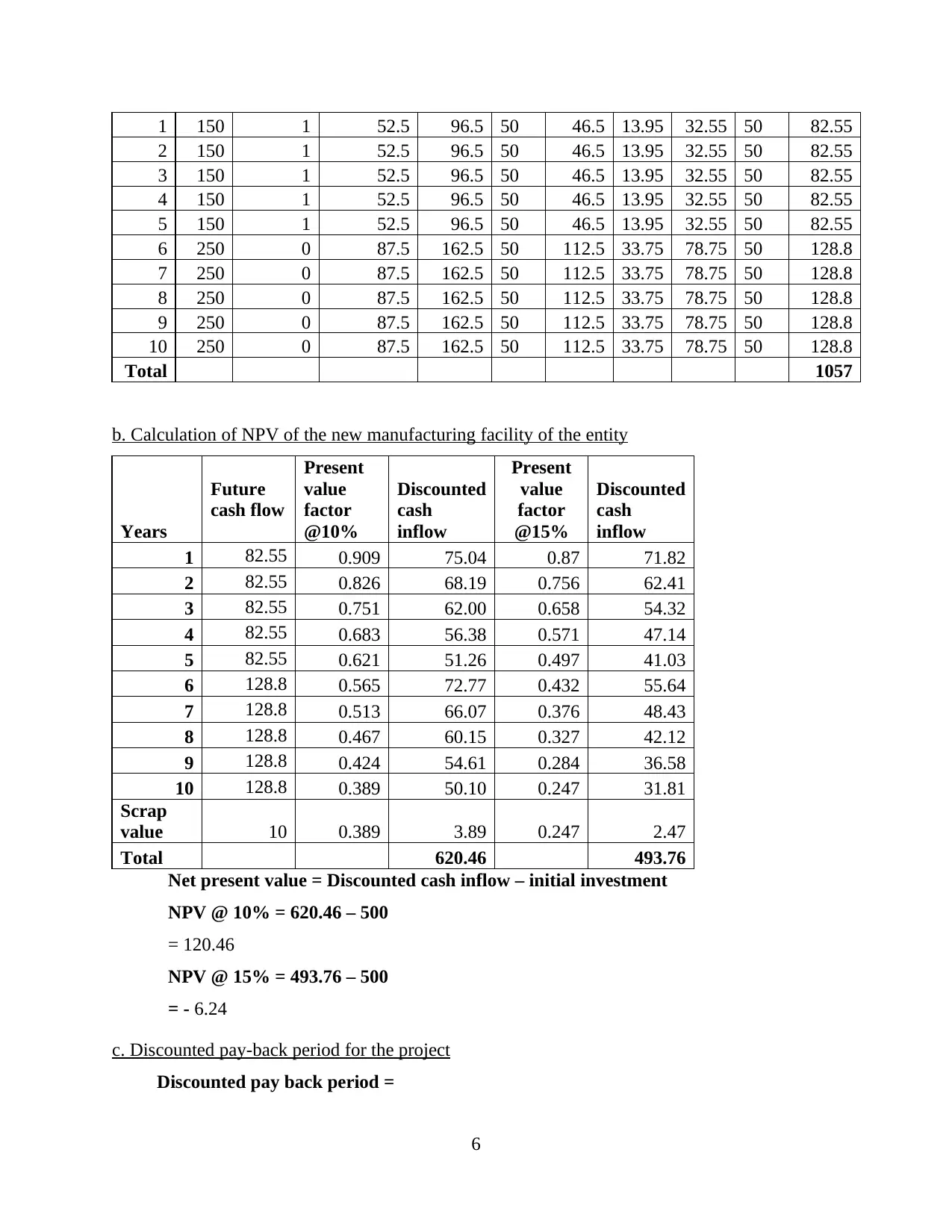
1 150 1 52.5 96.5 50 46.5 13.95 32.55 50 82.55
2 150 1 52.5 96.5 50 46.5 13.95 32.55 50 82.55
3 150 1 52.5 96.5 50 46.5 13.95 32.55 50 82.55
4 150 1 52.5 96.5 50 46.5 13.95 32.55 50 82.55
5 150 1 52.5 96.5 50 46.5 13.95 32.55 50 82.55
6 250 0 87.5 162.5 50 112.5 33.75 78.75 50 128.8
7 250 0 87.5 162.5 50 112.5 33.75 78.75 50 128.8
8 250 0 87.5 162.5 50 112.5 33.75 78.75 50 128.8
9 250 0 87.5 162.5 50 112.5 33.75 78.75 50 128.8
10 250 0 87.5 162.5 50 112.5 33.75 78.75 50 128.8
Total 1057
b. Calculation of NPV of the new manufacturing facility of the entity
Years
Future
cash flow
Present
value
factor
@10%
Discounted
cash
inflow
Present
value
factor
@15%
Discounted
cash
inflow
1 82.55 0.909 75.04 0.87 71.82
2 82.55 0.826 68.19 0.756 62.41
3 82.55 0.751 62.00 0.658 54.32
4 82.55 0.683 56.38 0.571 47.14
5 82.55 0.621 51.26 0.497 41.03
6 128.8 0.565 72.77 0.432 55.64
7 128.8 0.513 66.07 0.376 48.43
8 128.8 0.467 60.15 0.327 42.12
9 128.8 0.424 54.61 0.284 36.58
10 128.8 0.389 50.10 0.247 31.81
Scrap
value 10 0.389 3.89 0.247 2.47
Total 620.46 493.76
Net present value = Discounted cash inflow – initial investment
NPV @ 10% = 620.46 – 500
= 120.46
NPV @ 15% = 493.76 – 500
= - 6.24
c. Discounted pay-back period for the project
Discounted pay back period =
6
2 150 1 52.5 96.5 50 46.5 13.95 32.55 50 82.55
3 150 1 52.5 96.5 50 46.5 13.95 32.55 50 82.55
4 150 1 52.5 96.5 50 46.5 13.95 32.55 50 82.55
5 150 1 52.5 96.5 50 46.5 13.95 32.55 50 82.55
6 250 0 87.5 162.5 50 112.5 33.75 78.75 50 128.8
7 250 0 87.5 162.5 50 112.5 33.75 78.75 50 128.8
8 250 0 87.5 162.5 50 112.5 33.75 78.75 50 128.8
9 250 0 87.5 162.5 50 112.5 33.75 78.75 50 128.8
10 250 0 87.5 162.5 50 112.5 33.75 78.75 50 128.8
Total 1057
b. Calculation of NPV of the new manufacturing facility of the entity
Years
Future
cash flow
Present
value
factor
@10%
Discounted
cash
inflow
Present
value
factor
@15%
Discounted
cash
inflow
1 82.55 0.909 75.04 0.87 71.82
2 82.55 0.826 68.19 0.756 62.41
3 82.55 0.751 62.00 0.658 54.32
4 82.55 0.683 56.38 0.571 47.14
5 82.55 0.621 51.26 0.497 41.03
6 128.8 0.565 72.77 0.432 55.64
7 128.8 0.513 66.07 0.376 48.43
8 128.8 0.467 60.15 0.327 42.12
9 128.8 0.424 54.61 0.284 36.58
10 128.8 0.389 50.10 0.247 31.81
Scrap
value 10 0.389 3.89 0.247 2.47
Total 620.46 493.76
Net present value = Discounted cash inflow – initial investment
NPV @ 10% = 620.46 – 500
= 120.46
NPV @ 15% = 493.76 – 500
= - 6.24
c. Discounted pay-back period for the project
Discounted pay back period =
6
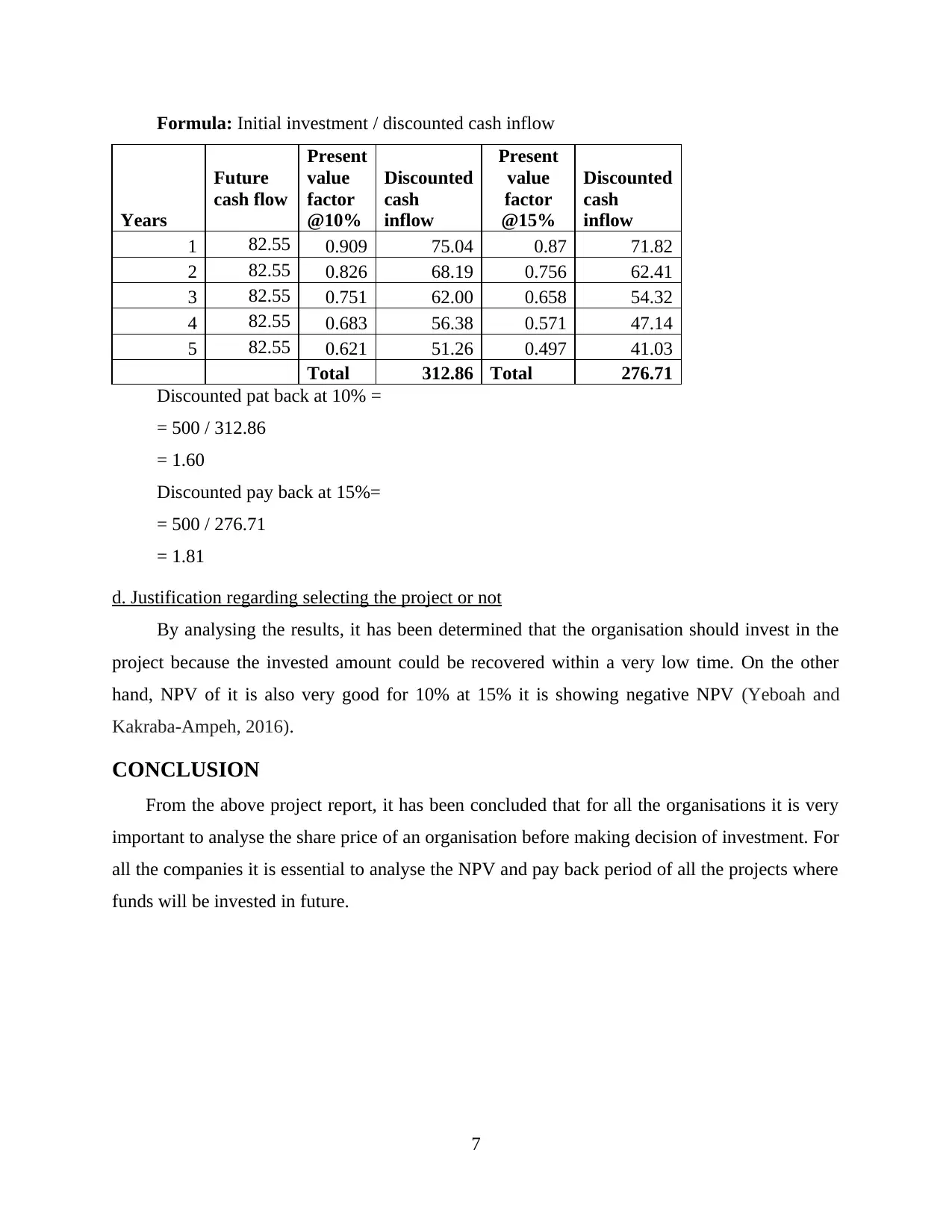
Formula: Initial investment / discounted cash inflow
Years
Future
cash flow
Present
value
factor
@10%
Discounted
cash
inflow
Present
value
factor
@15%
Discounted
cash
inflow
1 82.55 0.909 75.04 0.87 71.82
2 82.55 0.826 68.19 0.756 62.41
3 82.55 0.751 62.00 0.658 54.32
4 82.55 0.683 56.38 0.571 47.14
5 82.55 0.621 51.26 0.497 41.03
Total 312.86 Total 276.71
Discounted pat back at 10% =
= 500 / 312.86
= 1.60
Discounted pay back at 15%=
= 500 / 276.71
= 1.81
d. Justification regarding selecting the project or not
By analysing the results, it has been determined that the organisation should invest in the
project because the invested amount could be recovered within a very low time. On the other
hand, NPV of it is also very good for 10% at 15% it is showing negative NPV (Yeboah and
Kakraba-Ampeh, 2016).
CONCLUSION
From the above project report, it has been concluded that for all the organisations it is very
important to analyse the share price of an organisation before making decision of investment. For
all the companies it is essential to analyse the NPV and pay back period of all the projects where
funds will be invested in future.
7
Years
Future
cash flow
Present
value
factor
@10%
Discounted
cash
inflow
Present
value
factor
@15%
Discounted
cash
inflow
1 82.55 0.909 75.04 0.87 71.82
2 82.55 0.826 68.19 0.756 62.41
3 82.55 0.751 62.00 0.658 54.32
4 82.55 0.683 56.38 0.571 47.14
5 82.55 0.621 51.26 0.497 41.03
Total 312.86 Total 276.71
Discounted pat back at 10% =
= 500 / 312.86
= 1.60
Discounted pay back at 15%=
= 500 / 276.71
= 1.81
d. Justification regarding selecting the project or not
By analysing the results, it has been determined that the organisation should invest in the
project because the invested amount could be recovered within a very low time. On the other
hand, NPV of it is also very good for 10% at 15% it is showing negative NPV (Yeboah and
Kakraba-Ampeh, 2016).
CONCLUSION
From the above project report, it has been concluded that for all the organisations it is very
important to analyse the share price of an organisation before making decision of investment. For
all the companies it is essential to analyse the NPV and pay back period of all the projects where
funds will be invested in future.
7
⊘ This is a preview!⊘
Do you want full access?
Subscribe today to unlock all pages.

Trusted by 1+ million students worldwide

REFERENCES
Books and Journals:
Blackmore, L., 2017. El H elicoide and L a T orre de D avid as P hantom P avilions: R ethinking
S pectacles of P rogress in V enezuela. Bulletin of Latin American Research, 36(2),
pp.206-222.
Blackmore, R., 2019. The effects of commercial privileges in late medieval Bordeaux, 1348–
1449. French History.
Ducastel, A. and Anseeuw, W., 2018. 13 Large-scale land investments and financialisation of
agriculture. Ecology, Capitalism and the New Agricultural Economy: The Second Great
Transformation.
Kenfack, P. E., Nguiffo, S. and Nkuintchua, T., 2016. Land investments, accountability and the
law: Lessons from Cameroon. International Institute for Environment and
Development..
QUANSAH, J. D. G., SARPONG, M. and ASUMDA, D., 2018. Natural Resources Law II. 5th
May, 2018.
Sun, S. H., 2019. 01 Sydney Investor Forum 2019.
Yeboah, E. and Kakraba-Ampeh, M., 2016. Land investments, accountability and the law:
Lessons from Ghana. International Institute for Environmental and Development.
Online
Annual report of Blackmore. 2019. [Online]. Available through:
< https://www.blackmores.com.au/about-us/investor-centre/annual-and-half-year-
reports>
Blackmores Group Governance & Board of Directors. 2019. [Online]. Available through:
< https://www.blackmores.com.au/about-us/investor-centre/corporate-governance>
8
Books and Journals:
Blackmore, L., 2017. El H elicoide and L a T orre de D avid as P hantom P avilions: R ethinking
S pectacles of P rogress in V enezuela. Bulletin of Latin American Research, 36(2),
pp.206-222.
Blackmore, R., 2019. The effects of commercial privileges in late medieval Bordeaux, 1348–
1449. French History.
Ducastel, A. and Anseeuw, W., 2018. 13 Large-scale land investments and financialisation of
agriculture. Ecology, Capitalism and the New Agricultural Economy: The Second Great
Transformation.
Kenfack, P. E., Nguiffo, S. and Nkuintchua, T., 2016. Land investments, accountability and the
law: Lessons from Cameroon. International Institute for Environment and
Development..
QUANSAH, J. D. G., SARPONG, M. and ASUMDA, D., 2018. Natural Resources Law II. 5th
May, 2018.
Sun, S. H., 2019. 01 Sydney Investor Forum 2019.
Yeboah, E. and Kakraba-Ampeh, M., 2016. Land investments, accountability and the law:
Lessons from Ghana. International Institute for Environmental and Development.
Online
Annual report of Blackmore. 2019. [Online]. Available through:
< https://www.blackmores.com.au/about-us/investor-centre/annual-and-half-year-
reports>
Blackmores Group Governance & Board of Directors. 2019. [Online]. Available through:
< https://www.blackmores.com.au/about-us/investor-centre/corporate-governance>
8
1 out of 10
Related Documents
Your All-in-One AI-Powered Toolkit for Academic Success.
+13062052269
info@desklib.com
Available 24*7 on WhatsApp / Email
![[object Object]](/_next/static/media/star-bottom.7253800d.svg)
Unlock your academic potential
Copyright © 2020–2025 A2Z Services. All Rights Reserved. Developed and managed by ZUCOL.





